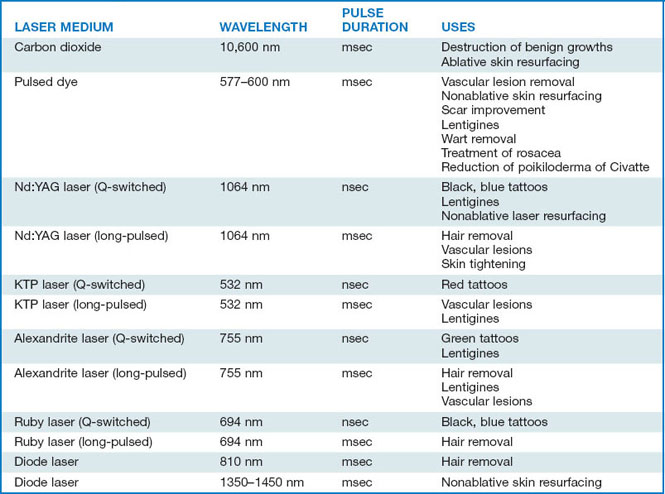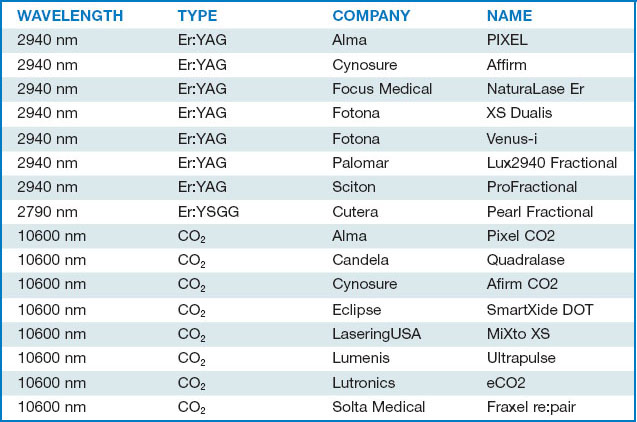Chapter 54 Lasers in dermatology
| LASER MEDIUM | WAVELENGTH | PROBLEMS |
|---|---|---|
| Argon | 488 nm, 512 nm | Scarring |
| Krypton | 520 nm, 568 nm | Scarring |
| Copper vapor | 511 nm, 578 nm | Ineffective |
| Pulsed pigment | 504 nm | Mechanical nightmare |
The new superpulsed and ultrapulsed CO2 lasers have powers up to 60 W and pulse duration in the range of 250 μsec to 1 msec. There are now many fractional CO2 lasers designed to reduce the side effects of CO2 laser ablation (Table 54-3).
Olbricht SM: Use of the CO2 laser in dermatologic surgery, J Dermatol Surg Oncol 19:364–369, 1993.
Goldberg DJ: Nonablative resurfacing, Clin Plastic Surg 27:287–292, 2000.
| LASER | MODE | USES |
|---|---|---|
| Nd:YAG, 1064 nm | Long-pulsed | Hair removal Blood vessels, nose Leg veins Skin tightening |
| Nd:YAG, 1064 nm | Q-switched | Black, blue tattoos Nevus of Ota |
| KTP, 532 nm | Long-pulsed | Facial telangiectasias |
| KTP, 532 nm | Q-switched | Red tattoos Epidermal pigmentation |
Table 54-7. Alexandrite Lasers
| LASER | MODE | USES |
|---|---|---|
| 755 nm | Q-switched | Tattoos (green, black) Brown spots |
| 755 nm | Long-pulsed | Hair removal Leg veins (1–2 mm blue) Brown spots |
| LASER | MODE | USES |
|---|---|---|
| 694 nm | Q-switched | Tattoos (black) Nevus of Ota |
| 694 nm | Long-pulsed | Hair removal |
| WAVELENGTH | PULSE DURATION | USES |
|---|---|---|
| 532 nm | 10–150 msec | Vascular lesions |
| 810 nm | 10–1000 msec | Hair removal Vascular lesions |
| 1320 nm | 20 msec | Nonablative resurfacing Acne scarring |
| 1450 nm | 3 msec | Nonablative resurfacing Acne scarring Acne treatment |
Since this first laser, there have been many nonablative lasers with a variety of wavelengths and theoretical mechanisms. These include 1410-nm, 1540-nm, and a combination of 1440- and 1320-nm light. These lasers are purported to treat acne scars, surgical scars, and facial photodamage, including fine rhytids and dyschromia, melasma, and striae distensae. Table 54-10 lists the nonablative fractional lasers.
Table 54-10. Nonablative Fractional Lasers
| NAME | TYPE | WAVELENGTH |
|---|---|---|
| Fraxel re:fine | Single-mode fiber | 1410 nm |
| Affirm | Nd:YAG | 1320 nm/1440 nm |
| Lux1440 Fractional | Nd:YAG | 1440 nm |
| Lux1540 Fractional | Er:glass | 1540 nm |
| Fraxel re:store | Erbium fiber | 1550 nm |
Narurkar VA: Nonablative fractional laser resurfacing, Dermatol Clin 27:473–478, 2009.
Fractional lasers are primarily used for cosmetic purposes. They help with mild to moderate facial rhytids, hyperpigmentation, and lentigines, and are very effective in helping acne scarring. Table 54-11 lists the ablative fractional lasers.
Raulin C, Greve B, Grema H: IPL technology: a review, Lasers Surg Med 32:78–87, 2003.
Key Points: Lasers in Dermatology









